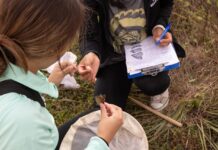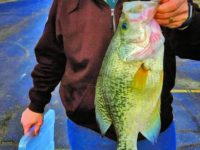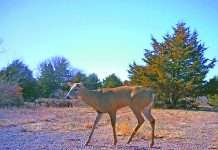COLORADO SPRINGS, Colo. – Colorado Parks and Wildlife aquatic biologists made their annual trek up Bear Creek in Colorado Springs on Monday in search of rare greenback cutthroat trout, also known as Colorado’s state fish.
Two CPW staffers wore heavy electronic gear strapped on their backs attached to long wands, resembling characters from Ghostbusters.
Accompanied by CPW staff carrying long nets and buckets, the teams slowly walked up the creek in their waders, struggling for solid footing and to avoid tangles of tree branches as they charged the water with small doses of electricity. The charges momentarily stunned the trout, giving staff a chance to net them.
The trout, listed as threatened by the U.S. Fish and Wildlife Service, were slipped into the buckets and soon handed over to biologists on the creek bank who stripped the males of their milt, or semen, to be mixed with the roe, or eggs, of female greenback cutthroat trout in a makeshift lab under a canopy on the side of the creek.
It was a long, strenuous day for the CPW team, but they gladly endured the early heat and later the rain that fell as they bushwhacked upstream through dense thickets. They persevered because the work is critical to preserving the last remaining population of genetically pure fish native to the South Platte watershed.
“The Bear Creek greenback cutthroat trout are an incredibly unique and special fish,” said Cory Noble, CPW aquatic biologist who teamed with Kevin Rogers, CPW aquatic researcher, to lead Monday’s spawning effort.
“Collecting the eggs and milt from these fish will help us to conserve and recover the species throughout its native range,” Noble said. “They will help infuse vital genetic diversity into our other brood sources and ultimately into the fish that we stock out on the landscape.”
It was a lot of work for a modest reward. The teams were only able to spawn three females Monday at their creekside lab from a handful of male fish collected. But they captured valuable milt that will be taken to a U.S. Fish and Wildlife hatchery in Leadville where Rogers said it will be used to fertilize the eggs of captive females and diversify the genetics of the brooding stock there.
“One drop of milt can fertilize hundreds of eggs, so this wild milt is extremely valuable to us in the hatchery,” Noble said. “We usually try to get as many males as possible in order to collect milt for fertilizing eggs at the hatchery.”
The spawning operation is a continuation of extensive work CPW aquatic biologists, U.S. Fish and Wildlife, U.S. Forest Service, Trout Unlimited, Great Outdoors Colorado, El Paso County, the city of Colorado Springs and other local government agencies have done to recover and conserve the species.
In 1937, greenback cutthroat trout were considered extinct, the victims of pollution from mining, pressure from fishing and competition from other trout species. Then, in the 1950s, small pockets of fish thought to be greenbacks were discovered in several drainages along the Arkansas and South Platte rivers. Biologists at the time gathered them at breeding stock in hatcheries and began spawning what they thought were greenbacks.
Turned out they were wrong. They were using close relatives but not authentic greenbacks.
In 2012, researchers from the University of Colorado published a study that compared the genetics of modern populations of cutthroat trout to samples collected over 100 years ago that are preserved in museums.
The genetic analysis determined nearly all the fish that scientists previously believed to be greenback cutthroat trout, native to the South Platte watershed, were in fact descendants of fish stocked from sources in the Colorado and White River drainages.
It seems there was only one population of cutthroat trout with the original South Platte genetics intact: in tiny Bear Creek on the western edge of Colorado Springs. Another twist: the authentic greenbacks aren’t native to Bear Creek. It is believed that in 1870s innkeeper, Joseph Jones, who wanted cutthroat for his guests to catch, stocked them in ponds he built along the creek.
Back to the 2012 discovery, fish and fertilized eggs were quickly collected from Bear Creek to be held as a brood source and refuge population at the Leadville National Fish Hatchery.
Each year since, CPW biologists have gone back to Bear Creek to collect milt and roe.
Photos: Courtesy Colorado Parks and Wildlife/Bill Vogrin




